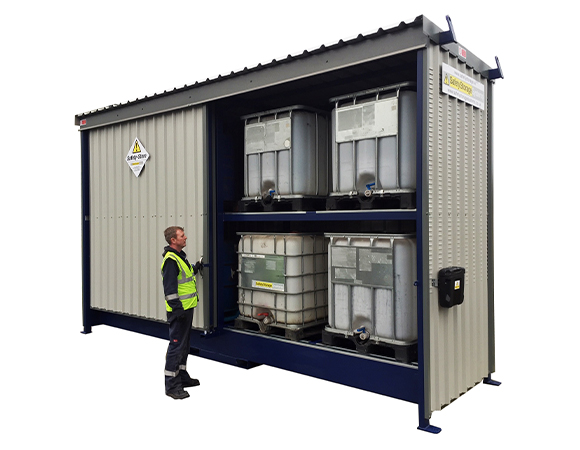
If your team are involved in handling, storing, or transporting hazardous chemicals, you’ll know that a leak or spill could have serious consequences. Reducing the risk of spillage is a must, but even so, accidents can happen, whether through human error or unpredictable extreme weather events. To help reduce the impact if the worst does happen, you’ll need to develop a chemical emergency response plan.
Creating your chemical spill response plan
Establishing an emergency response plan is a key part of safe chemical storage. According to the HSE, an on-site emergency plan produced in accordance with the Control of Major Accident Hazards (COMAH) regulations should address procedures for dealing with emergency containment situations so as to minimise the effects and limit danger to persons, the environment and property in the event of a spill.
Unfortunately, even a minor chemical spill can cause an industrial emergency when handling highly flammable or toxic substances. Incidents can quickly become life-threatening, which is why it’s important to create a detailed chemical spill response plan to ensure that staff are ready to swing into action should the need arise.
The following elements are key to an effective response plan:
1) Conduct a risk assessment
Assess the level of danger posed by the spill, establishing the chemicals involved and the quantities concerned. Estimate the size of the largest possible spill and whether any incompatible substances or conditions could cause a dangerous chemical reaction. Consider how any spilled chemicals could impact neighbouring businesses or properties.
2) Communication strategy
Actions taken in the first few minutes of a spillage can greatly affect the outcome, so preparation and communication are vital. Firstly, people in the immediate vicinity should be advised to stay clear. Next, your spill response team, all of whom should be trained to deal with the spilled materials, will be alerted. If health and safety are at risk, contact the emergency services immediately ensuring that you provide as much information as possible on the materials involved.
3) Contain the spillage
If it is safe to do so, and staff have put on the appropriate personal protective equipment (PPE), your team should take steps to contain the spill. Use a spill kit containing appropriate clean-up materials such as absorbent pads, neutralising acids or powder to soak up the hazardous material.
4) Clean-up procedure
Prepare any waste from the containment process for safe disposal. Containers will need to be marked as hazardous waste, as will used PPE. Next, the affected area needs to be cleaned using substances detailed in the relevant material safety data sheet (MSDS) to reduce the risk of further contamination.
Run regular chemical safety training
Once your response plan and spill kits are in place, it’s important to ensure that all staff know how to follow the relevant procedures and use the equipment provided. Be sure to develop procedures for different emergencies then reinforce this with practical training, simulations and drills.
Effective spill response training should incorporate the following elements:
- Hazard Identification: Teach employees how to recognize hazards and identify physical and environmental risks including fumes, fire risks or incompatible substances
- Using Spill Kits: Ensure staff are trained on the proper use of equipment, how to deploy absorbent pads, containment booms and how to neutralise acids and bases.
- Communication & Evacuation: Practice procedures for containment, evacuation and for notifying the emergency services. Ensure staff know how to collaborate with emergency responders and work as a team.
In high-pressure situations such as a hazardous chemical spill, it is vital that your team act quickly and confidently. Regular practice through repeated safety drills can increase their proficiency so it’s a good idea to conduct evacuations and simulations to test emergency readiness.
In order to mimic real-life situations and to prepare for any eventuality, think carefully about the scenarios you develop. You might want to focus on the chemical type to address a certain chemical properties such as toxicity or flammability and ensure an appropriate response. Alternatively, you might focus on the spill location or volume, which could influence the severity of the situation.
Not only do simulations work to identify any weaknesses in your response protocols, they also ensure staff can act safely and swiftly in a crisis.
Support to pre-empt emergencies
Careful preparation is key to a successful spill response. Of course, the best approach is to have a complete understanding of the chemical hazards at your facility and to put in place efficient chemical storage systems from the start.
Storing your hazardous chemicals in Bunded Chemical Stores will greatly reduce the effects of a chemical spill as the spilled chemical is retained in the Bund of the Chemical Store where it can be safely recovered
To mitigate risks and ensure compliance, Safety Storage Systems can work with you to develop a tailored emergency response strategy. From safety infrastructure such as built-in ventilation and containment systems, to effective training and proper protocol, we can enhance your hazardous chemical handling and response procedure. Ensuring you have the tools to enhance safety and reduce risks before they escalate into an emergency.
Contact us today to learn how we can ensure the best solution for your chemical storage needs.